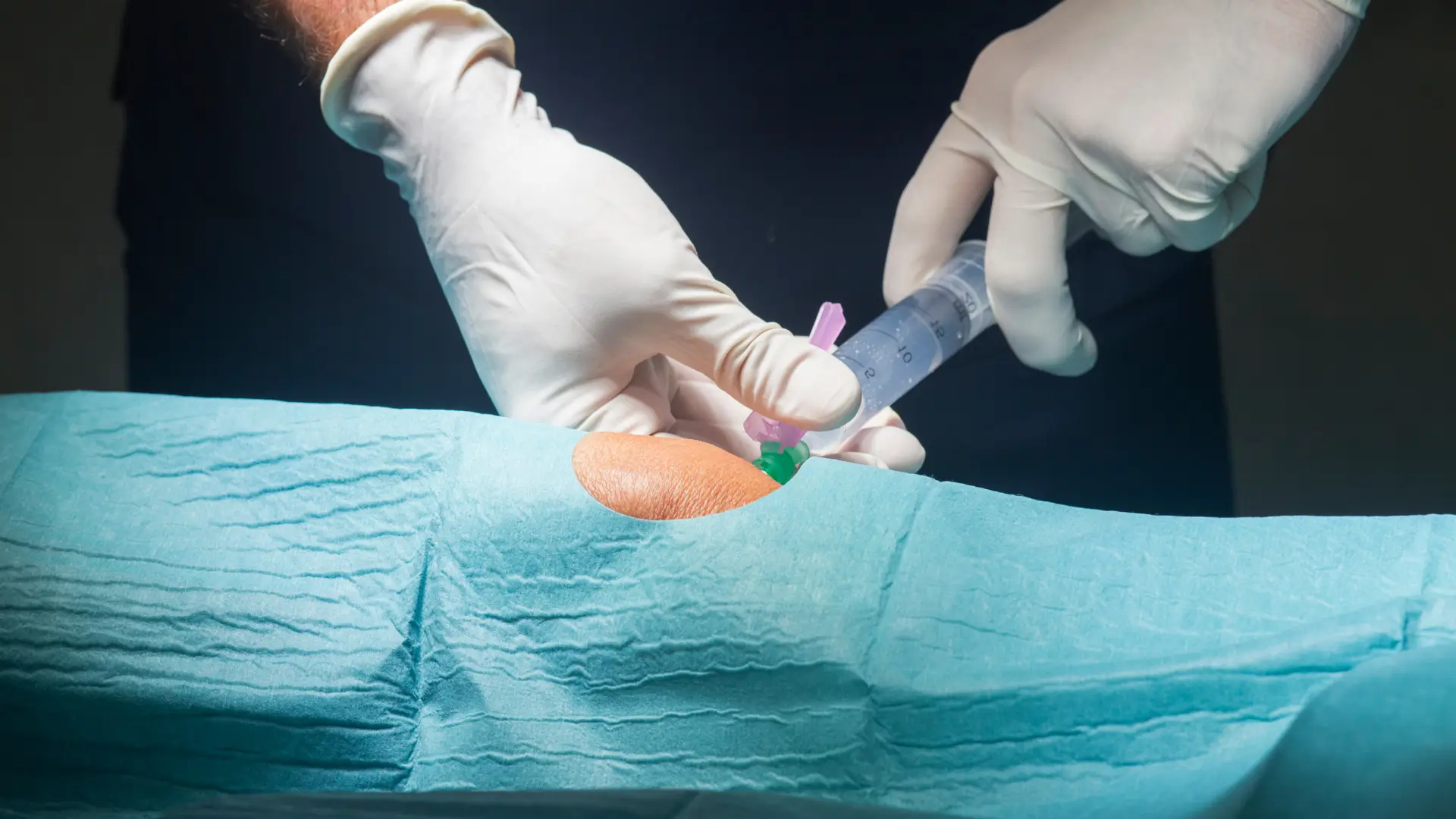According to Peck et al. (2021), viscosupplementation demonstrates the ability to reduce pain and enhance joint functional mobility. This comprehensive review highlights hyaluronic acid injections as an effective non-surgical solution for knee osteoarthritis.
Hyaluronic acid injections have emerged as a popular solution for individuals experiencing knee osteoarthritis (OA). Healthcare providers administer these injections directly into the joints, allowing patients to resume their daily activities and active lifestyles. In particular, Synvisc injections effectively relieve knee OA pain, significantly improving patients’ quality of life.
This article will explore Synvisc knee injections, indications, contraindications, proper administration, and clinical efficacy.
Key Takeaways
- Medical professionals typically recommend viscosupplements when conservative therapies and simple analgesics have not worked.
- Patients suffering from early to severe OA can benefit from Synvisc injection treatments.
- In addition to knowing its indications, medical professionals should also remember Synvisc’s contraindications and precautions for a safe treatment procedure.
- A thorough consultation can help providers align Synvisc treatment and dosage based on the patient’s needs, goals, medical history, knee osteoarthritis condition, and overall health to achieve optimal outcomes.
- Medical research and clinical studies have extensively observed Synvisc’s efficacy and safety in treating knee osteoarthritis (OA).
About: Medica Depot is your trusted all-in-one supplier, offering a range of high-quality medical injectables and supplies. If you’re looking to buy Synvisc wholesale, you can do so on Medica Depot quickly and easily. We offer a worry-free experience in searching for the best and most popular products on the market. Whether for health professionals, plastic surgeons, dermatologists, licensed estheticians, or other specialists, we can offer genuine, brand-name products you may need. With Medica Depot, we prioritize serving you better to improve the patient’s quality of life.
What Is Synvisc?

Viscosupplementation is a non-surgical solution for individuals suffering from knee osteoarthritis. It uses hyaluronic acid injections administered directly into the affected joint to provide symptomatic relief. Medical professionals typically recommend viscosupplements when conservative therapies and simple analgesics have not worked.
Additionally, Synvisc is a popular viscosupplement used to treat knee pain caused by osteoarthritis (OA). Synvisc, also known as hylan G-F 20, mimics the hyaluronic acid (HA) in the joint’s synovial fluid. The HA in synovial fluid loses quantity and quality over time, and Synvisc works to restore its viscoelastic properties.
Synvisc ingredients mainly comprise HA derived from chicken combs, ensuring its high molecular weight. This injection therapy works as a lubricant and shock absorber for the joint, reducing friction, pain, and inflammation. By temporarily relieving knee OA symptoms, patients can experience an improved quality of life and better joint movement.
Indications for Synvisc Use
Medical professionals can ensure a safe and effective Synvisc treatment for each patient. However, it’s essential to understand the indications for Synvisc use, and a discussion with the patients can give them comprehensive knowledge about injection therapy.
Synvisc knee injections and other viscosupplements are not first-line therapies for treating knee osteoarthritis (OA). However, they can be efficient and long-lasting when these non-pharmacologic therapies have failed. It’s worth noting that individuals should seek medical professionals’ guidance when receiving Synvisc knee injections.
This injection therapy has become known for its high efficacy and safety in knee osteoarthritis (OA). Patients suffering from early to severe OA can benefit from the viscosupplement injection. Unfortunately, Synvisc manufacturer has yet to establish the safety and effectiveness of Synvisc in locations other than the knee and conditions other than OA.
Contraindications and Precautions

From knowing its indications, medical professionals should also remember Synvisc’s contraindications and precautions for a safe treatment procedure. Moreover, they can discuss these factors with the patients, engage them in their treatment, and create a tailored treatment plan for their Synvisc injections.
- Patients with Allergies to Avian Proteins: Synvisc derived its hyaluronic acid from chicken combs, which may cause allergic reactions in patients with allergies to avian proteins, feathers, egg products, etc. Providers should not continue the use if patients have known hypersensitivity to these products.
- Infection at the Injection Site: Medical professionals should avoid administering Synvisc to knees with joint infection, skin infection or disease, or infection in the area surrounding the injection site. This may cause further complications, so providers must delay the Synvisc administration.
- Precautions for Patients with Bleeding Disorders: While Synvisc does not explicitly mention specific precautions for patients with bleeding disorders, this could potentially lead to bleeding complications. Discussing this with your trusted doctor before proceeding or discontinuing the procedure is crucial.
Furthermore, the Synvisc manufacturer has yet to establish the safety and efficacy of Synvisc injections for pregnant women, lactating women, and children under 21 years old. It’s advisable to prevent receiving Synvisc injections to avoid possible risks.
Administration Techniques

Proper Synvisc administration can help knee osteoarthritis (OA) patients achieve their goals. Medical professionals must directly administer these intra-articular injections into the affected knee joint. They should perform the Synvisc injection using an aseptic injection technique.
- Injection Site and Dosage: The injection requires direct administration into the knee joint. Medical professionals should consider the contraindications and precautions for the Synvisc injections. So, how many times can you get Synvisc injections? For Synvisc, each syringe contains 2.25 mL of the solution, while Synvisc One dosage requires a full 6 mL syringe for each knee.
- Frequency of Administration: Viscosupplement brands vary in number of injections per cycle. A complete Synvisc cycle needs three injections given at a weekly interval, typically on days 1, 8, and 15. Meanwhile, the manufacturer produced Synvisc One as a single-injection therapy. These treatments usually last for up to six (6) months.
Healthcare providers must properly prepare patients with knowledge about treatment and engage them in creating a personalized treatment plan. A thorough consultation can help providers align Synvisc treatment and dosage based on the patient’s needs, goals, medical history, knee osteoarthritis condition, and overall health to achieve optimal outcomes.
Providers can also help the patient’s journey to recovery, specifically in their aftercare for their knee joints. After the injection, patients must avoid strenuous or knee-stressing activities for about 48 hours. Moreover, applying ice briefly or resting the knee can help alleviate Synvisc side effects like swelling and pain at the injection site. However, if symptoms persist, seek medical attention.
Clinical Efficacy and Safety
Medical research and clinical studies have extensively observed Synvisc’s efficacy and safety in treating knee osteoarthritis (OA). Synvisc’s clinical efficacy trials have shown that it can deliver six months of relief for chronic knee OA pain. Moreover, at 12 months, patients experienced 44.8% pain reduction from baseline compared to another viscosupplement.
It also demonstrated rapid and significant knee OA relief as early as week one up to week 26, compared to a saline control group. Furthermore, no severe adverse events (AEs) were observed, and the most common AEs include pain in the injected knee, swelling in the injected knee, and joint effusion.
While limited resources show Synvisc’s comparison with other viscosupplements, it’s worth noting that these viscosupplementation therapies offer temporary pain relief to knee OA patients, and individual responses differ. Nonetheless, Synvisc has proven its safety and efficacy in various trials, earning medical professionals’ trust in delivering symptomatic relief.
Conclusion
Synvisc is a remarkable medical advancement, a viscosupplement injection used to reduce joint pain caused by osteoarthritis (OA). It’s indicated for knee OA patients when first-line therapies have not delivered adequate relief. Medical professionals can ensure patients receive a safe and effective Synvisc treatment by following its specific contraindications, precautions, and proper administration techniques.
Proper injection technique and appropriate dosage can help maximize Synvisc’s benefits and achieve optimal outcomes. Clinical studies have demonstrated its safety and efficacy, making it a viable option for those seeking symptomatic knee OA relief. Patients must consult their trusted doctors to determine the most suitable treatment option.
FAQs
1. What is Synvisc?
Synvisc is a viscosupplement injection used to treat knee pain caused by osteoarthritis. It is a non-surgical solution that uses hyaluronic acid injections administered directly into the affected joint to provide symptomatic relief.
2. Who can benefit from Synvisc injections?
Patients suffering from early to severe knee osteoarthritis can benefit from Synvisc injections. Providers typically recommend when conservative therapies and simple analgesics have not worked.
3. What are the contraindications and precautions for Synvisc injections?
Medical professionals should not administer Synvisc injections to knees with joint infection, skin infection disease, or infection in the area surrounding the injection site. Patients with allergies to avian proteins and bleeding disorders should also avoid Synvisc injections.
4. How long does the relief from Synvisc injections last?
The duration of relief from Synvisc injections varies from patient to patient. Some patients may experience relief for several months, while others may experience relief for up to 6 months. It is important to note that Synvisc injections do not cure osteoarthritis, and thus, repeated injections may be necessary to maintain pain relief.
References
- Peck, J., Slovek, A., Miro, P., Vij, N., Traube, B., Lee, C., Berger, A. A., Kassem, H., Kaye, A. D., Sherman, W. F., & Abd-Elsayed, A. (2021b). A Comprehensive Review of Viscosupplementation in Osteoarthritis of the Knee. Orthopedic Reviews. https://doi.org/10.52965/001c.25549
- SYNVISC Prescribing Information. (n.d.). In Sanofi US. Retrieved April 30, 2024, from https://products.sanofi.us/synvisc/synvisc.pdf









